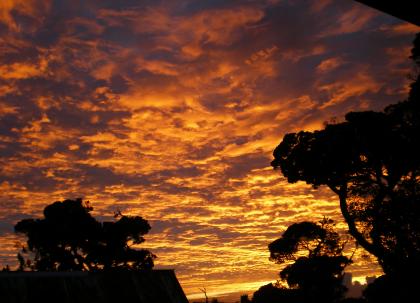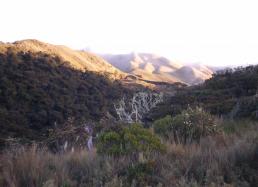5: Sunsets & Subalpine Grasslands
We've just completed our surveys in an extensive area of subalpine bamboo grassland that extends from our camp at 2,750 meters in elevation to the peak of Mt. Pulag at 2,922 meters. Our campsite is the place that's used for overnighting by hikers who go to the peak, usually to see the sun rise or set (both of which are quite spectacular, as you can see in the photo above).
The park is visited by over 2,000 hikers (they refer to themselves as “mountaineers”) each year, with the numbers increasing rapidly. This is a pretty new phenomenon, since political unrest prevented most people from traveling to remote areas during much of the 1980s and 1990s. Because the hikers all hire local people as guides and porters, and often buy souvenirs and food, they adds a great deal to the local economy and provides incentive to the local people to maintain the area as a park. To some degree, this counters the pressure to convert the park to vegetable farms, and so it's quite welcome.
The mossy forest here is mature and undisturbed, and so we look forward to learning what mammals live here. But first, we began by sampling in the bamboo grassland, where no mammal surveys have ever been conducted. Since this is the very highest habitat on Luzon, and because some people have suggested that it might be a relict habitat from the last Ice Age, when it was cooler and drier in the Philippines, we've been anxious to find out what mammals live here. The subalpine grassland covers at least 10 square kilometers, so it's quite a large area (see the photo below).
Basically, there are two rival hypotheses: if this is a relict habitat from the Ice Age, then we might find that there are endemic species that live here—and perhaps nowhere else in the Philippines—since the habitat is largely absent elsewhere. We've been daydreaming about finding new tiny mice that feed on tiny bamboo shoots, or small burrowing species that feed on insects. But we've also recognized that other people have said that the grassland is caused by people setting fire to the area, which kills all of the trees (except a few fire-resistant pines).
Supposedly, people have set the fires for centuries for two reasons: first, to create habitat for deer, which love to feed on the tender young shoots that emerge after a fire; and second, to clear the land so that, back in the days of fierce tribal warfare (primarily prior to the 1920s), folks could see potential enemies coming. If fires are indeed the reason for this habitat, we wouldn't expect to find any new or endemic species. Instead, we'd likely find perhaps only the very low-density, low-diversity mammal communities that we've seen many times in grassy areas at lower elevation, where burns are common and frequent.
Well, the purpose of research is to answer questions—and sometimes the answer is not the most exciting one. After a week of careful and thorough surveying of the subalpine grassland by our hard-working crew, we've caught very few mammals, and they're exactly the same species we catch in frequently burned areas at lower elevations. No new species, no weird adaptations.
In fact, one of the more common species we found is Rattus exulans, the ricefield rat, which isn't even native to the Philippines and is usually the most abundant species in burned, grassy areas. It's found in areas with almost no leaf litter or humus—just the charred stems of grass and bamboo. All of this supports the hypothesis of a fire-based habitat. This is very important to know, because it tells us that the next habitat down in elevation—the upper mossy forest—is likely to be highest natural habitat on Luzon.
So, tomorrow we'll begin to trap in the upper mossy forest. At this point, it looks pretty good—absolutely no disturbance that we can see, aside from a few trails. It's spectacular forest, with gnarled trees covered by thick layers of moss in which orchids and ferns grow in abundance. A thick layer of mossy leaf litter and humus covers the ground. It should be quite interesting to see what lives there; we're keeping our fingers crossed!
More soon,
Larry




